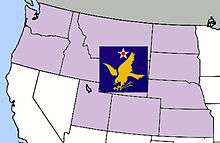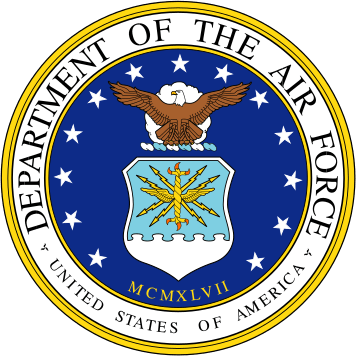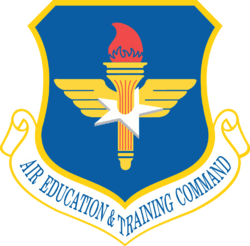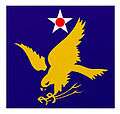Second Air Force
| Second Air Force | |
|---|---|
|
Brig. Gen. O.G. Mannon, left, commander of the 82d Training Wing, renders a salute to the flags of the 50 United States during a parade at Sheppard AFB at the base parade grounds. | |
| Active | 19 October 1940 – present |
| Country |
|
| Branch |
|
| Part of |
|
| Garrison/HQ | Keesler Air Force Base, Mississippi |
| Motto(s) | Second to None |
| Engagements |
|
| Decorations |
|
| Commanders | |
| Current commander | Major General Robert D. LaBrutta |
| Senior Enlisted Advisor | Command Chief Master Sergeant David Staton |
| Notable commanders | Alfred K. Flowers |
| Insignia | |
| Emblem of the Second Air Force |
.png) |
The Second Air Force (2 AF; 2d Air Force in 1942) is a USAF numbered air force responsible for conducting basic military and technical training for Air Force enlisted members and support officers. In World War II the CONUS unit defended the Northwestern United States and Upper Great Plains regions and during the Cold War, was Strategic Air Command unit with strategic bombers and missiles. Elements of Second Air Force engaged in combat operations during the Korean War; Vietnam War, as well as Operation Desert Storm.
History
The Northwest Air District of the GHQ Air Force was activated on 19 October 1940 at McChord Field along with 3 other CONUS districts and organized on 16 January 1941.[1] The district was redesignated 2nd Air Force on 9 April 1941.[1] 5th Bombardment Wing was assigned to Second Air Force up to 5 September 1941.
2nd Air Force

On 11 December 1941, four days after the Pearl Harbor attack, 2d Air Force was placed under Western Defense Command. However, on 5 January 1942, it was returned to the Air Force Combat Command (a redesignation of GHQAF after creation of the United States Army Air Forces on 20 January 1941), and later placed directly under Headquarters AAF when Air Force Combat Command was dissolved in March 1942.
From December 1941, 2d Air Force organized air defense for the northwest Pacific Ocean coastline of the United States (1940–1941) and flew antisubmarine patrols along coastal areas until October 1942. It appears that immediately after 7 December 1941, only the 7th, 17th, 39th and 42d Bombardment Groups under II Bomber Command were available for this duty. In late January 1942, elements of the B-25 Mitchell-equipped 17th Bombardment Group at Pendleton Field, Oregon were reassigned to Columbia Army Air Base, South Carolina ostensibly to fly antisubmarine patrols off the southeast coast of the United States, but in actuality came to prepare for the Doolittle Raid against Japan.
In January 1942, the 2d Air Force was withdrawn from the Western Defense Command and assigned the operational training of units, crews, and replacements for bombardment, fighter, and reconnaissance operations. It received graduates from Army Air Forces Training Command flight schools; navigator training; flexible gunnery schools and various technical schools, organized them into newly activated combat groups and squadrons, and conducted operational unit training (OTU) and replacement training (RTU) to prepare groups and replacements for deployment overseas to combat theaters.
As the Second Air Force it became predominantly the training organization of B-17 Flying Fortress and B-24 Liberator heavy bombardment groups. Nearly all new heavy bomb groups organized after Pearl Harbor were organized and trained by Second Air Force OTU units, then were deployed to combat commands around the world. After most of the heavy bombardment groups had completed OTU training, the Second Air Force conducted replacement training of heavy bombardment combat crews and acquired a new mission of operational and replacement training of very heavy bombardment (B-29 Superfortress) groups and crews.
Designated the Second Air Force on 18 September 1942, starting in mid-1943 the unit's training of B-17 and B-24 replacement crews began to be phased out, and ressigned to First, Third and Fourth Air Forces as the command began ramping up training of B-29 Superfortress Very Heavy bomb groups, destined for Twentieth Air Force. Under the newly organized XX Bomber Command, B-29 aircraft were received from Boeing's manufacturing plants and new combat groups were organized and trained. XX Bomber Command and the first B-29 groups were deployed in December 1943 to airfields in India for Operation Matterhorn operations against Japan.
A football team made up of Second Air Force personnel defeated Hardin-Simmons University in the 1943 Sun Bowl.[2]
XXI Bomber Command, the second B-29 combat command and control organization was formed under Second Air Force in March 1944 with its combat groups beginning to deploy to the Mariana Islands in the Western Pacific beginning in December 1944. A third B-29 organization, XXII Bomber Command was formed by Second Air Force in August 1944, however the organization never got beyond forming Headquarters echelon and Headquarters squadron. Inactivated before any operational groups were assigned, as XX Bomber Command units were reassigned from India to the Marianas, eliminating need for the command.
On 13 December 1944, First, Second, Third and Fourth Air Force were all placed under the unified command of the Continental Air Forces (CAF) with the Numbered Air Forces becoming subordinate commands of CAF. The training of B-29 groups and replacement personnel continued until August 1945 and the end of the Pacific War. With the war's end, Second Air Force was inactivated on 30 March 1946. In what was effectively a redesignation, the headquarters staff and resources were used to create Fifteenth Air Force, which became the first Numbered Air Force of the new Strategic Air Command ten days later.
Cold War
The command was reactivated on 6 June 1946 under Air Defense Command, at Fort Crook, Nebraska. During this period of the force's history its home base was redesignated Offutt Air Force Base. The Second Air Force assumed responsibility for the air defense of certain portions of the continental United States. In 1947, the 73d Bomb Wing was reactivated with the 338th and 351st Bomb Groups being assigned to it, both reserve B-29 Superfortress organizations. The wing was assigned to Second Air Force. A third group, the 381st was added in 1948. However SAC was having enough difficulties keeping its front-line active duty bomb units in the air to maintain even minimal pilot proficiency in the late 1940s. The wing and its bomb groups were all inactivated in 1949.
The Second Air Force was also assigned the reserve 96th Bomb Wing, which was later redesignated an air division, and several C-46 Commando troop carrier groups under the 322d Troop Carrier Wing. One of these groups was the 440th Troop Carrier Group. It was again inactivated on 1 July 1948.

The Second Air Force was (re)-activated and assigned to Strategic Air Command on 1 November 1949 at Barksdale AFB, LA. The initial organization of Second Air Force as part of SAC was:
- 6th Air Division, MacDill AFB, Florida (assigned 10 February 1951)
- 305th Bombardment Wing (MacDill AFB) (B-29)
- 306th Bombardment Wing (MacDill AFB) (B-47A)(Initial B-47 Stratojet Operational Training Unit – Not on Operational Alert)
- 307th Bombardment Wing (MacDill AFB) (B-29)
- Detached for Korean War combat service with Far East Air Force, Kadena AB, Okinawa
- 40th Air Division, Turner AFB, Georgia (assigned 14 March 1951)
- 31st Fighter Escort Wing (Turner AFB) (F-84)
- 108th Fighter Wing (Turner AFB) (F-47D) (Federalized New Jersey Air National Guard wing)
37th and 38th Air Divisions joined Second Air Force on 10 October 1951. 37th Air Division was responsible for Lockbourne Air Force Base and Lake Charles Air Force Base, and 38th Air Division was located at Hunter Air Force Base, Georgia.
With the end of fighting in Korea, President Eisenhower, who had taken office in January 1953, called for a "new look" at national defense. The result: a greater reliance on nuclear weapons and air power to deter war. His administration chose to invest in the Air Force, especially Strategic Air Command. The nuclear arms race shifted into high gear. The Air Force retired nearly all of its propeller-driven bombers and they were replaced by new Boeing B-47 Stratojet medium jet bombers. By 1955, the Boeing B-52 Stratofortress heavy bomber would be entering the inventory in substantial numbers and as a result, Second Air Force grew both in scope and in numbers.
After the Korean War, the history of Second Air Force became part of Strategic Air Command's history, as B-47 Stratojet, and later B-52 Stratofortress and KC-135 Stratotanker aircraft entered SAC's inventory. During the Cold War, Second Air Force aircraft and intercontinental ballistic missiles (ICBM)s stood nuclear alert, providing a deterrence against an attack on the United States by the Soviet Union. In 1966, an order of battle for the force showed units spread across most of the United States, from the 6th Strategic Aerospace Wing at Walker AFB, New Mexico, to the 11th Strategic Aerospace Wing at Altus AFB, Oklahoma, to the 97th Bombardment Wing at Blytheville AFB, Arkansas.[3]
During the Vietnam War, squadrons of 2d Air Force B-52 Stratofortesses (primarily B-52Ds, augmented by some B-52Gs) were deployed to bases on Guam, Okinawa and Thailand to conduct Arc Light bombing attacks on communist forces. The 28th Bombardment Wing was among the units assigned this duty.[4] The 2d Air Force organization was inactivated during the post-Vietnam drawdown, on 1 January 1975, with those 2 AF bomb wings not inactivated and/or those 2 AF bases not closed, redistributed to 8 AF and 15 AF.
With the end of the Cold War and the restructuring of Strategic Air Command, Second Air Force was reactivated and became the steward for reconnaissance and battlefield management assets, based at Beale AFB, California. This assignment lasted from 1 September 1991 until 1 July 1993, when it was inactivated by Air Combat Command.
Air Education and Training Command
Second Air Force was reactivated and reassigned on 1 July 1993 to Keesler AFB, Mississippi. Its mission became conducting basic military and technical training for Air Force enlisted members and support officers at five major AETC training bases in the United States.
The command has the mission is to train mission ready graduates to support combat readiness and to build 'the world's most respected air and space force'. To carry out this mission, Second Air Force manages all operational aspects of nearly 5,000 active training courses taught to approximately 250,000 students annually in technical training, basic military training, medical and distance learning courses. Training operations across Second Air Force range from intelligence to computer operations to space and missile operations and maintenance.
The first stop for all Air Force, Air National Guard and Air Force Reserve enlisted airmen is basic military training (BMT) at Lackland AFB, Texas. After completing BMT, airmen begin technical training in their career field specialties, primarily at five installations: Goodfellow, Lackland, and Sheppard Air Force bases in TX; Keesler AFB, MS; and Vandenberg AFB, CA. Each base is responsible for a specific portion of formal technical training airmen require to accomplish the Air Force mission. Instructors conduct technical training in specialties such as aircraft maintenance, civil engineering, medical services, computer systems, security forces, air traffic control, personnel, intelligence, fire fighting, and space and missile operations.
Commissioned officers attend technical training courses for similar career fields at the same locations.
Wings and Groups under Second Air Force are:
- 37th Training Wing Lackland Air Force Base Texas
Provides Basic Military Training to Air Force recruits as well as technical training in logistics and security police/law enforcement career fields. - 81st Training Wing Keesler Air Force Base Mississippi
Provides training in Aviation Resource Management, weather, basic electronics, communications electronic systems, communications computer systems, air traffic control, airfield management, command post, air weapons control, precision measurement, education and training, financial management and comptroller, information management, manpower and personnel. - 17th Training Wing Goodfellow Air Force Base Texas
Provides training in intelligence and firefighting career fields. Also provides training to Army, Navy and Marine detachments. - 82d Training Wing Sheppard Air Force Base Texas
Provides specialized technical training, medical, and field training for officers, Airmen, and civilians of all branches of the military, other DoD agencies, and foreign nationals. - 381st Training Group Vandenberg AFB, California
Provides qualification training for intercontinental ballistic missiles (ICBM), space surveillance, missile warning, spacelift, and satellite command and control operators. It also performs initial and advanced maintenance training on air-launched missiles (ALM) and ICBM's. It conducts training in joint space fundamentals and associated computer maintenance. The group also conducts qualification and orientation training for Air Force Space Command (AFSPC) staff and senior-level personnel, as well as instructor enhancement in support of operational units. - 602d Training Group Keesler Air Force Base Mississippi
Provides fully combat mission capable Airmen to all Combatant Commanders in direct support of the Joint Expeditionary Tasking (JET) mission.
In 2006, Second Air Force was assigned the responsibility of coordinating training for Joint Expeditionary Tasked (JET) Training Airmen. These Airmen are assigned to perform traditional US Army duties in Iraq, Afghanistan and the Horn of Africa. An Expeditionary Mission Support Group was formed to provide command and control of these JET Airmen as they are trained at US Army Power Projection Platforms across the US prior to deploying to their assigned Area of Responsibility (AOR). This group has been named the 602d Training Group.
In 2007, Second Air Force was given responsibility to provide curricula and advice to the Iraqi Air Force as it stands up its own technical training and branch specific basic training among others. This mission is known as "CAFTT" for Coalition Air Forces Technical Training.
Lineage

- Established as Northwest Air District on 19 Oct 1940
- Activated on 18 Dec 1940
- Re-designated: 2d Air Force on 26 Mar 1941
- Re-designated: Second Air Force on 18 Sep 1942
- Inactivated on 30 Mar 1946.
- Activated on 6 Jun 1946.
- Inactivated on 1 Jul 1948.
- Activated on 1 Nov 1949.
- Inactivated on 1 Jan 1975.
- Activated on 1 Sep 1991.
- Inactivated on 1 Jul 1993.
- Activated on 1 Jul 1993
Assignments
|
|
Stations
- McChord Field, Washington, 18 December 1940
- Fort George Wright, Washington, 9 January 1941
- Colorado Springs AAF, Colorado, 13 June 1943 – 30 March 1946
- Fort Crook, Nebraska, 6 June 1946 – 1 July 1948
- Barksdale AFB, LA, 1 Nov 1949 – 1 Jan 1975
- Beale AFB, CA, 1 Sep 1991 – 1 Jul 1993
- Keesler AFB, MS. 1 Jul 1993–
Components
Commands
|
|
Divisions
|
|
Wings
- 5th Bombardment Wing: 18 December 1940 – 1 September 1941.
- 11th Pursuit Wing: 18 December 1940 – 1 October 1941.
- 20th Bombardment Wing: 18 December 1940 – 1 September 1941.
References
![]() This article incorporates public domain material from the Air Force Historical Research Agency website http://www.afhra.af.mil/.
This article incorporates public domain material from the Air Force Historical Research Agency website http://www.afhra.af.mil/.
- 1 2 AAF: The Official Guide to the Army Air Forces (2ND PRINTING ed.). June 1944.
2ND AIR FORCE—Colorado Springs, Colo., Brig. Gen. U. G. Ent. Organized―As NW Air District 16 Jan. '41; redesignated 2nd Air Force 9 Apr. '41. Function ―Same as 1st Air Force.
- ↑ Bolding, Mark. "Sun Bowl 1943". mmbolding.com. Archived from the original on 27 August 2009. Retrieved 25 November 2016.
- ↑ Serrano, Jose Maria (26 April 2007). "US Strategic Air Command (SAC) 1966". orbat.com. Archived from the original on 23 May 2014. Retrieved 25 November 2016.
- ↑ 1966 order of battle
- Maurer, Maurer (1983). Air Force Combat Units of World War II. Maxwell AFB, Alabama: Office of Air Force History. ISBN 0-89201-092-4.
- Ravenstein, Charles A. (1984). Air Force Combat Wings Lineage and Honors Histories 1947–1977. Maxwell AFB, Alabama: Office of Air Force History. ISBN 0-912799-12-9.
External links
- Second Air Force Factsheet
- News Stories:
- Air Force News: http://www.aetc.af.mil/News/ArticleDisplay/tabid/5115/Article/263318/army-air-force-leaders-examine-in-lieu-of-training.aspx
- Air Force News: http://www.aetc.af.mil/News/ArticleDisplay/tabid/5115/Article/263675/ilo-training-prepares-airmen-to-serve-in-combat-operations.aspx
- Air Force News: Change of Command http://archive.is/20121212040908/http://www.af.mil/news/story.asp?id=123166976
- PRESENTATION TO THE SUBCOMMITTEE ON READINESS COMMITTEE ON ARMED SERVICES UNITED STATES HOUSE OF REPRESENTATIVES: http://www.airforcemag.com/testimony/Documents/2007/July%202007/073107Gibson.pdf




